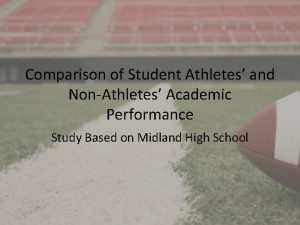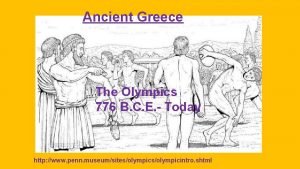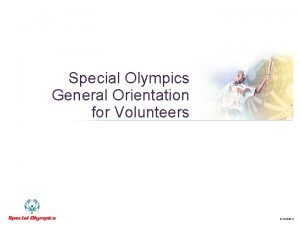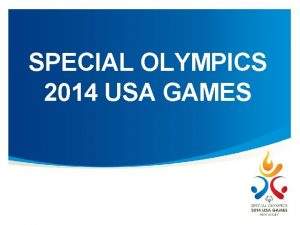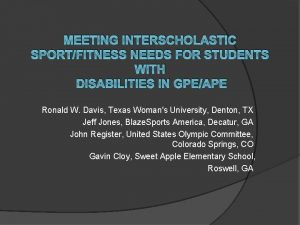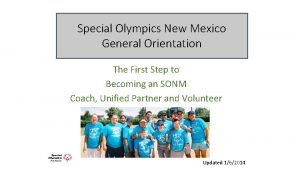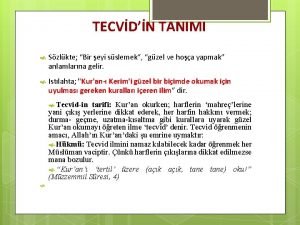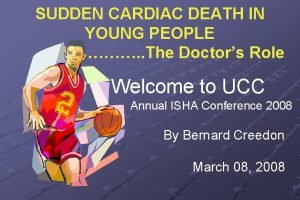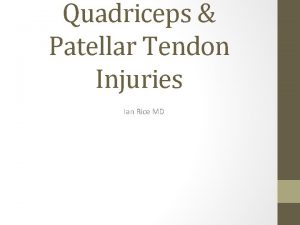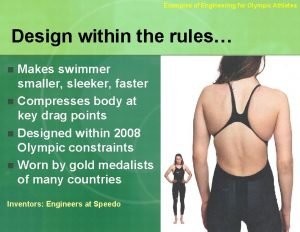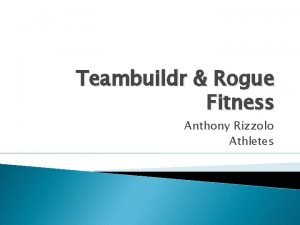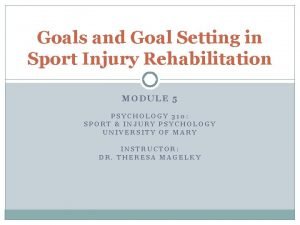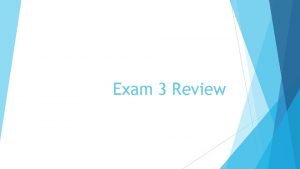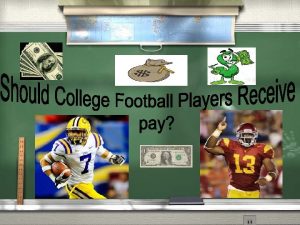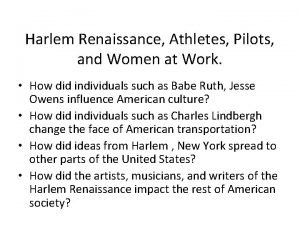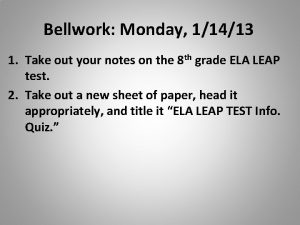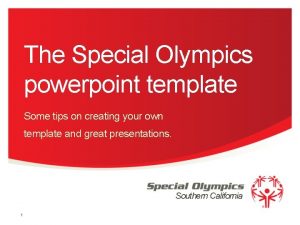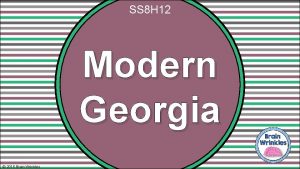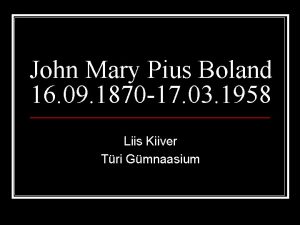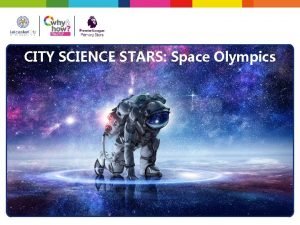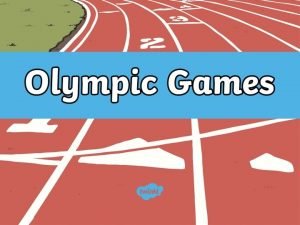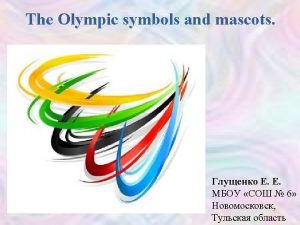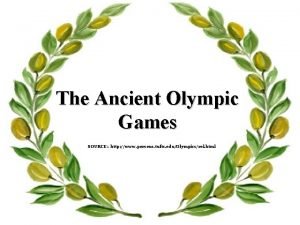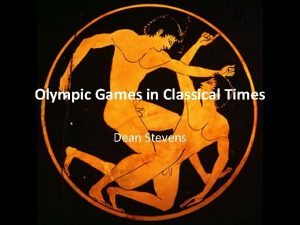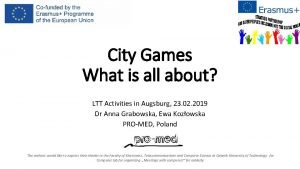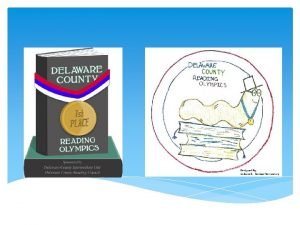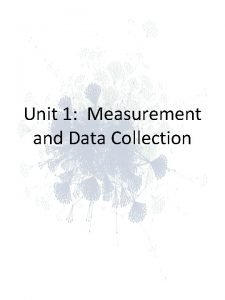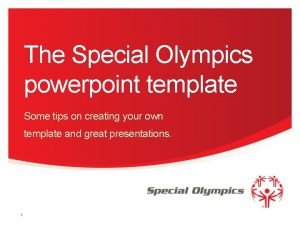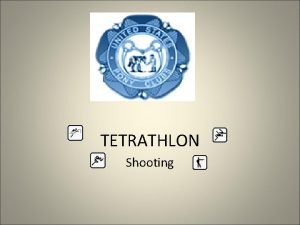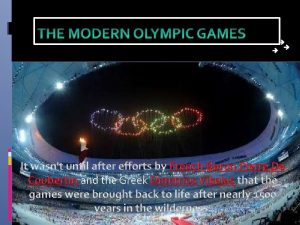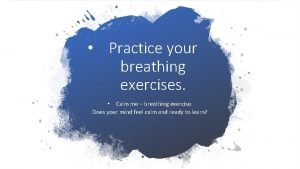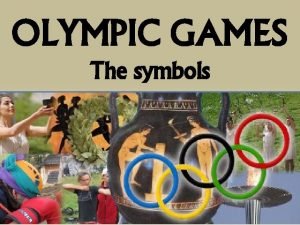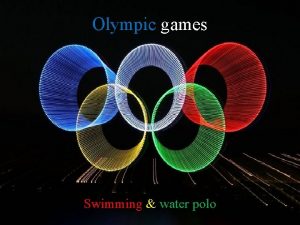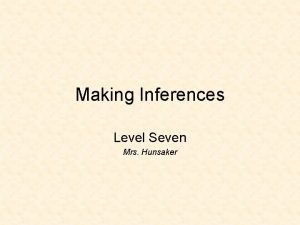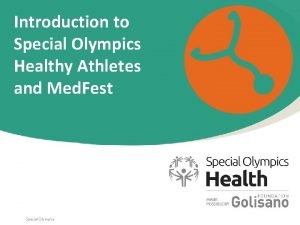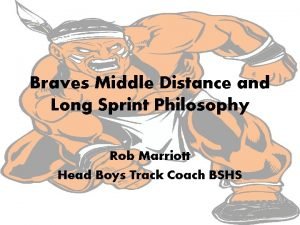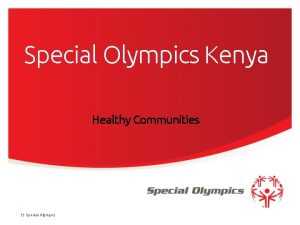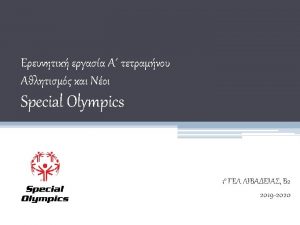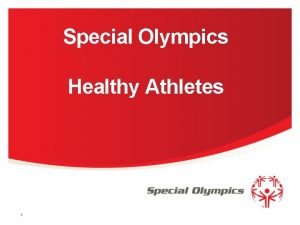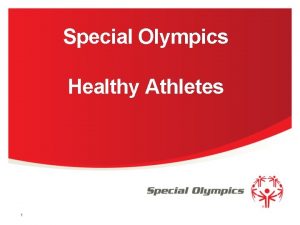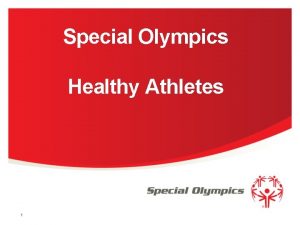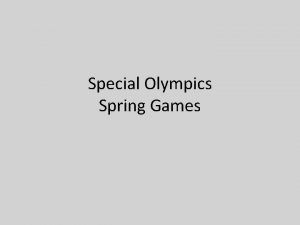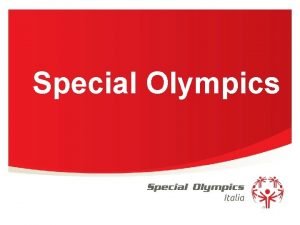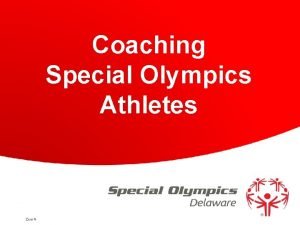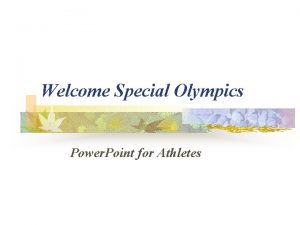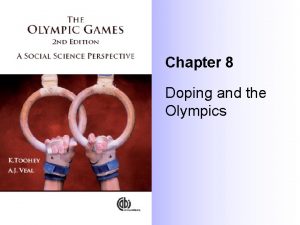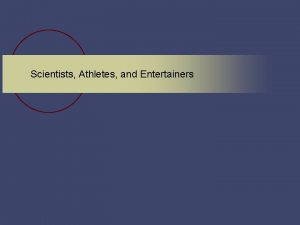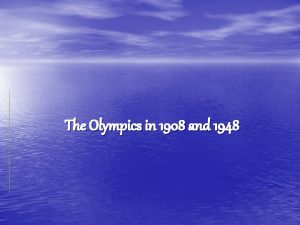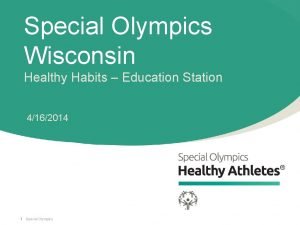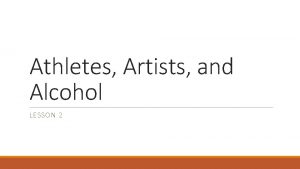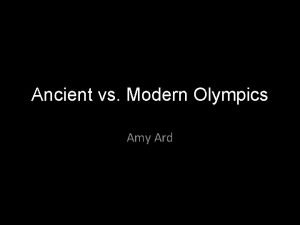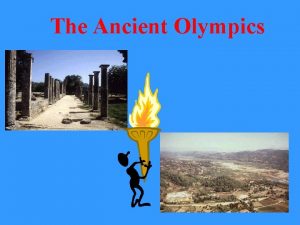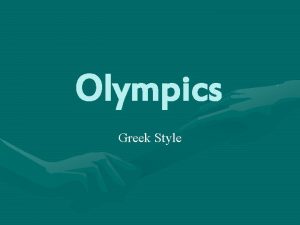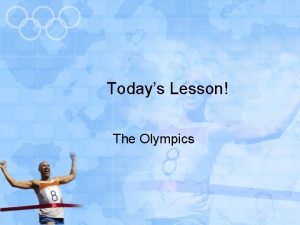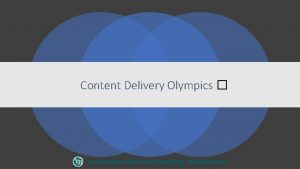Introduction to Special Olympics Healthy Athletes and Med
























































- Slides: 56

Introduction to Special Olympics Healthy Athletes and Med. Fest Special Olympics

What Will be Covered In This Training? ü ü History of Special Olympics International Overview of Special Olympics Health & Healthy Athletes Understanding the population we serve Med. Fest Protocols and Purpose

Special Olympics provides yearround sports training and athletic competition in a variety of Olympictype sports for children and adults with intellectual disabilities, giving them continuing opportunities to develop physical fitness, demonstrate courage, experience joy and participate in a sharing of gifts, skills, and friendship with their families, other Special Olympics athletes, and the community

Special Olympics: Origin • 1962: Shriver Camp – Summer camp in the backyard of Eunice Shriver’s home in Washington, D. C. • July 20, 1968: First International Special Olympics Summer Games held in Chicago • Aug 2, 1968: Special Olympics officially becomes incorporated

Special Olympics: Now • 32 Olympic-type summer and winter sports • Over 5 million athletes in more than 190 countries • Over 1 million coaches and volunteers, worldwide • More than 100, 000 competitions around the world each year • More than 220 competitions hosted daily

What Will be Covered In This Training? ü ü History of Special Olympics International Overview of Special Olympics Health & Healthy Athletes Understanding the population we serve Med. Fest Protocols and Purpose

4 Focus Areas • • Health Education Community Sport

Special Olympics Health, made possible by the Golisano Foundation, was created in 1997 with Healthy Athletes®. However, it has grown incredibly since then…. Conduct health screenings Train health care professionals Provide yearround inclusive health, fitness, and wellness programming Support systemic policy change initiatives

The Reality

Why is the reality? Barriers to good health for people with ID include: • Insufficient provider training • Limited prevention education • Limited self-advocacy • Attitudes/Discrimination/ Discomfort/Lack of Awareness • Cultural beliefs • Increased poverty • Poor enforcement of laws/acts

Insufficient Training for Health Care Providers • 81% of graduating medical students in the U. S. report not having any clinical training on the care of people with IDD • 90% of US primary care residency programs offer no training in caring for people with IDD

Goals of Healthy Athletes • Train health care professionals and students • Improve access and health care for Special Olympics athletes at event based health screenings • Make referrals to local health practitioners when appropriate • Collect, analyze and disseminate data on the health status and needs of persons with intellectual disabilities • Advocate for improved health policies and programs for persons with intellectual disabilities

Healthy Athletes Special Olympics is the largest sporting organization in the world for people with intellectual disabilities (ID). Special Olympics is creating a world where people with ID have the opportunity to be healthy. Opening Eyes (Vision) Special Smiles (Dentistry) Healthy Hearing (Audiology) Fit Feet (Podiatry) Fun Fitness (Physical Therapy) Med. Fest (Sports Physicals) Health Promotion (Health and Wellness) Strong Minds (Emotional Well-being)

What Will be Covered In This Training? ü ü History of Special Olympics International Overview of Special Olympics Health & Healthy Athletes Understanding the population we serve Med. Fest Protocols and Purpose

Intellectual Disability: Definition • Refers to a disability that originates before age 18 and is characterized by significant limitations in both intellectual functioning and in adaptive behaviors – American Association on Intellectual and Developmental Disabilities (AAIDD) definition: <18 yo – DSM-5 definition: during the developmental period

Breaking down the Definition • Intellectual functioning – Refers to general mental capacity – May be measured by an Intelligence Quotient (IQ) test • IQ test score<70 -75 indicates a limitation in intellectual functioning • Adaptive behaviors – Refers to skills that are needed to live, work, and play in the community • Includes communication, self-care, and social skills – Put another way, adaptive behaviors are the conceptual, social, and practical skills that people learn and perform in their everyday lives

Intellectual Disability 1. 5% Profound 3. 5% Severe 10% Moderate 85% Mild

How does ID relate to term Developmental Disabilities? • Developmental disability (DD): before age 18 • Intellectual disability (ID) • Limitations in intellectual functioning limitations • Limitations in adaptive behaviors • Other DDs – Autism spectrum disorder – ADHD – Specific learning disorder – Motor disorders – Communication disorders Developmental Disability Intellectual Disability/ID Other DDs

Intellectual Disability Neuromotor Dysfunction Seizure Disorder Sensory Differences Environment Genetics Neurodevelopmental Disorder Cerebrogenic Conditions Somatic Conditions Cephalic & Cervical Cardiac & Pulmonary Skeletal & Muscular Endocrine & Metabolic Communication Difficulty Gastro – Intestinal Psychiatric Diagnoses Genito – Urinary Health and Behavioral Consequences How does ID relate to the term neurodevelopmental disorders?

Causes of ID • For many people, the cause of intellectual disability is unknown • Some of the most common causes of intellectual disability include – Fragile X syndrome – Down syndrome – Fetal alcohol syndrome – Genetic conditions, birth defects, serious head injury, stroke, or certain infections

Not All Developmental Disabilities Result in an Intellectual Disability DOWN SYNDROME F AS INTELLECTUAL DISABILITY AUTISM CEREBRAL PALSY F X S DEVELOPMENTAL DISABILITIES

Communicating with patients with ID

What Will be Covered In This Training? ü ü History of Special Olympics International Overview of Special Olympics Health & Healthy Athletes Understanding the population we serve Med. Fest Protocols and Purpose

Med. Fest Purpose • Provides a free pre-participation sports physical exam that conforms to a standard of care • Serves as a part of the healthcare infrastructure by providing a service that many people with ID have difficulty in obtaining • Fulfills several additional purposes • To recruit new athletes to the Special Olympics movement • To provide health professionals and health professions students clinical experience with patients with ID in a non-acute setting • To foster partnerships between Special Olympics and the community

Athlete Medical Form • Pages 1 -2 (Health History) should be filled out prior to arrival to Med. Fest – Includes demographic information, past medical history, allergies and meds • Page 3 – Physical Exam – Height/weight/BMI, vitals, vision screening – Physical exam & recommendations • Page 4 – Only for referrals – Filled out by consulted physician as needed

Med. Fest Stations 1. Check-in 2. Height/weight 3. Basic Vision Exam 4. Vitals 5. Physical Exam 6. Check-outt

Med. Fest Stations 1. Check-in • Athlete welcome area • Athlete is checked-in and linked up with their previously submitted Health History

Health History

Med. Fest Stations 2. Height/weight • Weight taken in lbs or kgs on professional grade scale • • If athlete uses wheelchair and is weighed in wheelchair, please note on form Height taken in “in” or “cm” using a stadiometer • Previous height, wingspan, or tape measure are possible alternatives, please note on form

Med. Fest Stations 3. Vision • Basic 20/40 (or 6/12) vision screen using a Lea Chart

Lea Chart Checking for Vision at the 20/40 level • Have athlete stand at 10 feet away • Athlete reads chart for the 20/40 line • • Lea Wall Chart Symbols for athletes to hold If athlete is non-verbal, ask him/her to point to symbol in hand Mark if they fail (for referral to Opening Eyes or otherwise) NOTE: Vision is not necessarily a reason to not clear an athlete. Accommodations can be made for some sports.

Med. Fest Stations 3. Vitals • • Done at separate station outside exam room or within exam room, depending on set-up and volunteers Blood Pressure, Pulse, O 2 Sat, and Temperature


Blood Pressure Protocol • BP measurement is required in only one arm – Test right arm first, if possible • If normal, you are done! • If abnormal, let the athlete rest, drink water, and re-test with manual cuff • If measurement continues to be abnormal, test the other arm

Screening Reference Guide - Blood Pressure (Adult and Pediatric) Use this blood pressure chart to work out what the blood pressure readings mean. This is a screening and not intended to be a diagnosis for high blood pressure as we are only doing one reading. NOTE: BP reading is considered abnormal if either value (systolic or diastolic) is outside the normal range. Table 1: Children age 13 + and adults 1 BP Reading Category Systolic mm. Hg (upper number) Less than 90 Less Than 120 -129 130 -139 Hypotensive and Normal and Elevated and High Blood Pressure or Hypertension Stage 1 High Blood Pressure 140 -159 or Hypertension Stage 2 -a Non-Clearance for Blood Pressure Readings Below High Blood Pressure 160 -180 or Hypertension Stage 2 -b Hypertensive Crisis Higher Than and/or 180 Diastolic mm. Hg (lower number) Less Than 60 Less Than 80 80 -89 Action 90 -99 Referral 100 -120 Non-Clearance of Athlete until further follow-up Immediate (Urgent) referral to medical services Higher than 120 Referral none Referral

Table 2: Children Age 8 -12 Blood Pressure Values Requiring Further Evaluation by Medical Professional 2 Age Blood Pressure Values* Systolic mm Diastolic mm Hg Hg Non-Clearance Levels for Youth 5 103 63 Cleared, but recommended Referral 6 105 66 Cleared, but recommended Referral 120/81 or above → 7 106 68 Cleared, but recommended Referral 121/83 or above → 8 107 69 Cleared, but recommended Referral 122/84 or above → 9 107 70 Cleared, but recommended Referral 124/86 or above → 10 108 72 Cleared, but recommended Referral 124/87 or above → 11 110 74 Cleared, but recommended Referral 126/88 or above → 12 113 75 Cleared, but recommended Referral 128/90 or above → 119/78 or above → Plot athletes BP based on age and height to determine clearance. *Any BP reading repeatedly at or above the systolic or diastolic values listed in table 2 requires further evaluation.

Blood Pressure Protocol: Youth aged ≥ 13 & Adults HTN stage 1 (130 -139 systolic and 80 -89 diastolic) HTN stage 2 b (160 -179 systolic or 110 -119 diastolic) • If >160 systolic or >100 diastolic do NOT clear for participation until further evaluation

Med. Fest Stations 1. Check-in 2. Height/weight 3. Basic Vision Exam 4. Vitals 5. Physical Exam 6. Check-outt

Physical Exam • Each athlete should arrive to the physical exam station with height/weight, vision, and vitals stations complete • Goal is for the exam to take a total of 8 -10 minutes • To inform your exam: • Review Health History (pages 1 and 2) • Review vitals (top of page 3)

Who completes the physical exam? Who signs the form? • The form must be signed by a Licensed Medical Professional qualified to conduct physical exams and prescribe medications. – Typically, this includes licensed physicians (MD or DO), nurse practitioners, or physician assistants – Chiropractors may not perform the SOI sports physical • Students/Trainees of these fields may also perform the physical exam, but it must be done under the supervision of a licensed medical professional – Supervisor must sign the form and is responsible for the validity of the information obtained by students – Students do NOT sign the form

Physical Exam

Physical Exam

Physical Exam Clearances 44

Most Common Reasons Not to Clear Cardiac • irregular HR • grade 3/6 murmur or higher • Blood pressure above 160/100 Pulmonary: O 2 Sat <90% on room air Abdominal: Hepatomegaly or splenomegaly Neurologic: signs or symptoms of spinal cord compression Acute infection: febrile illnesses Use your clinical judgment

Potential Reasons to Clear, but Restrict Poorly controlled seizure disorders - should avoid sports involving water Bleeding disorders or osteogenesis imperfect - should avoid contact sports Pregnancy - should avoid equestrian sports Single functional eye - should use protective eyewear Use your clinical judgment

Referrals-filled out by consulting physician after Med. Fest, if applicable

Average for Clearance/Referrals • Full Clearance: 70 -90% of athletes • Full Clearance, with non-urgent referrals: 10 -30% of athletes -Athlete with sub-optimal vision correction - Athlete with stage 1 hypertension • Clearance, with restrictions: 0 -10% of athletes -Athlete with frequent seizures, cleared for bocce but not swimming • No Clearance, Pending Further Evaluation: 0 -5% of athletes

Med. Fest Stations 1. Check-in 2. Height/weight 3. Basic Vision Exam 4. Vitals 5. Physical Exam 6. Check-out

Clearance Examples

Clearance Examples • An athlete with Down syndrome • The athlete has a lifelong history of bowel and bladder control problems • No other neurological symptoms • No neurological findings on physical exam Clear

Clearance Examples • An athlete with Down syndrome • The athlete has a lifelong history of bowel and bladder control problems – but it has gotten worse within the past three years • No other neurological complaints • No neurological findings on physical exam Do not clear – refer.

Clearance Examples • An athlete has a history of seizures but has not had one within the past year • No other findings on history or physical Clear

Clearance Examples • An athlete has a history of seizures AND has had one within the past year • No other findings on history or physical Potentially Not Cleared – Find out more information: may depend on sport being played, frequency, medication changes, etc.

Final thoughts Scrubs/dress comfortably. No white coats please. • • • You may be given a volunteer t-shirt to wear during the event Bring your stethoscope and reflex hammer

Thank you for supporting Special Olympics! 56 Special Olympics

REGISTER TODAY: http: //bit. ly/Med. Fest 2018 INSERT DATE & LOCATION OF EVENT Questions? Feedback on training? CONTACT: INSERT Contact information Free t-shirt and lunch provided! Healthy Hearing (Audiology) Opening Eyes (Vision) Special Smiles (Dental) Med. Fest (Sports Physicals)
 Athletes vs non athletes academic performance
Athletes vs non athletes academic performance Ancient olympics vs modern olympics
Ancient olympics vs modern olympics 776bce
776bce 776bce
776bce Special olympics vs paralympics
Special olympics vs paralympics 2014 special olympics
2014 special olympics Podium victory
Podium victory Special olympics creed
Special olympics creed Special olympics new mexico
Special olympics new mexico Special olympics hq
Special olympics hq Tıvalı mufassal
Tıvalı mufassal Nutrition and productivity
Nutrition and productivity Healthy soil healthy life poster ideas
Healthy soil healthy life poster ideas Healthy community poster
Healthy community poster Healthy nurse healthy nation
Healthy nurse healthy nation Extreme harmful eating behaviors
Extreme harmful eating behaviors Seven cruel hours of our lives
Seven cruel hours of our lives All athletes have an innate preference
All athletes have an innate preference Athletes suddenly dying
Athletes suddenly dying Famous athletes with osgood schlatters disease
Famous athletes with osgood schlatters disease Athletes body engineers
Athletes body engineers Anthony rizzolo
Anthony rizzolo Fungi kingdom characteristics
Fungi kingdom characteristics Goal setting theory
Goal setting theory Motor behavior includes three sub disciplines
Motor behavior includes three sub disciplines Should college athletes be paid thesis statement
Should college athletes be paid thesis statement Harlem renaissance athletes
Harlem renaissance athletes Parts of sperm
Parts of sperm Ants at the olympics poem questions and answers
Ants at the olympics poem questions and answers Xxxfacebook
Xxxfacebook Olympics slide template
Olympics slide template 1996 centennial olympics button
1996 centennial olympics button John pius boland
John pius boland Science skills olympics
Science skills olympics Opening ceremony ancient greek olympics
Opening ceremony ancient greek olympics Wordsmith writing olympics
Wordsmith writing olympics When did the olympics start
When did the olympics start The values of olympics are ---------- *
The values of olympics are ---------- * Snowlets
Snowlets Olympic purpose
Olympic purpose Ancient greek olympics primary sources
Ancient greek olympics primary sources Ltt activities
Ltt activities Dciu reading olympics
Dciu reading olympics 420 m = _____cm
420 m = _____cm Olympic powerpoint template
Olympic powerpoint template Tetrathlon olympics
Tetrathlon olympics Ancient olympic games
Ancient olympic games What is the olympic creed
What is the olympic creed Olympics signs
Olympics signs Ellie olympics
Ellie olympics Symbol of olympic
Symbol of olympic Winter olympics trivia
Winter olympics trivia Beijing olympics 2008
Beijing olympics 2008 Origin of the olympics
Origin of the olympics Olympics
Olympics 1972 olympics
1972 olympics Sportlarissa
Sportlarissa
